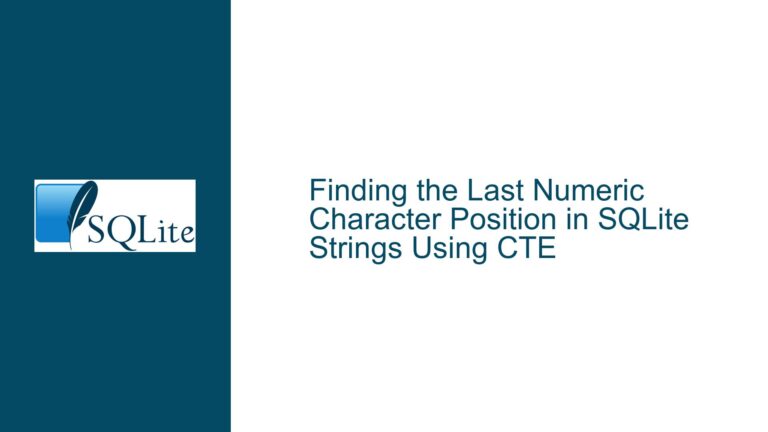Incorrect Query Results Due to View and LEFT JOIN Interaction in SQLite
Issue Overview: Mismatched Results When Modifying OR false in EXISTS Subquery
The core issue revolves around an SQLite query returning inconsistent results when a seemingly redundant OR false condition is removed from a WHERE clause within an EXISTS subquery. The original query involves a LEFT OUTER JOIN between a table and a subquery derived from a view, combined with negation logic (NOT(...)). The problem manifests as follows:
- Initial Query: Includes
OR falsein the WHERE clause of the EXISTS subquery. This query returns a row from tablet0(value1). - Modified Query: Removes
OR false. Despite logical equivalence (sinceX OR falsesimplifies toX), the modified query returns no results.
This discrepancy violates the expectation that the two queries should behave identically. The root cause lies in how SQLite’s query optimizer handles subqueries, joins, and negation logic when views or complex expressions are involved. The issue was confirmed as a bug in SQLite and resolved in a specific check-in, but understanding its mechanics is critical for avoiding similar pitfalls.
Possible Causes: Query Optimization Edge Cases with Views and Negation
Three primary factors contribute to this inconsistency:
Incorrect Flattening of Subqueries Involving Views
SQLite’s query optimizer attempts to "flatten" subqueries and views into the main query to simplify execution. However, when a view (v0) is referenced inside a subquery that itself is part of a LEFT JOIN, flattening might incorrectly alter the NULL-handling semantics. In the original query, the subquerysubq_0referencesref_0.wkey(a column from the outer query), creating a correlated subquery. If the optimizer mishandles this correlation during flattening, it can prematurely evaluate conditions or misapply JOIN constraints.Improper Handling of Negation and OR false
TheNOT(...)operator in the WHERE clause interacts with theOR falsein a way that exposes a flaw in how SQLite short-circuits logical expressions. TheOR falsemight have been preventing the optimizer from simplifying the expression tree, inadvertently preserving the correct evaluation order. RemovingOR falsecould allow the optimizer to rewrite the condition in a way that ignores NULL propagation rules. Specifically:- The expression
NOT (subq_0.c1 <> (ref_0.wkey + ref_1.pkey))evaluates toTRUE,FALSE, orNULLdepending onsubq_0.c1. - When
subq_0.c1is NULL (due to the LEFT JOIN not finding a match),subq_0.c1 <> ...becomes NULL, andNOT(NULL)is also NULL. - The
OR falsein the original query forces the entire condition to resolve toNULL OR false, which isfalse, making the outerNOT(...)evaluate totrue. WithoutOR false, the condition simplifies differently, leading to incorrect NULL handling.
- The expression
LEFT JOIN Semantics with Correlated Subqueries
The subquerysubq_0referencesref_0.wkey, which binds it to the outer query’st0table. When combined with a LEFT JOIN, the join condition (ref_1.c1 = subq_0.c1) may produce NULLs insubq_0.c1if no match is found. However, if the optimizer fails to account for the correlation correctly, it might treatsubq_0as an uncorrelated subquery, leading to incorrect NULL assignments or premature filtering.
Troubleshooting Steps, Solutions & Fixes: Diagnosing and Resolving Optimization-Induced Inconsistencies
Step 1: Simplify the Query to Isolate the Problem
Begin by reducing the query to its minimal reproducible form while preserving the core issue:
- Replace the view
v0with its definition (SELECT 1) directly in the subquery. - Remove unnecessary columns and tables. For example, since
v0always returns1, the subquerysubq_0simplifies toSELECT ref_0.wkey AS c1 FROM (SELECT 1) AS ref_4.
Simplified Query:
SELECT * FROM t0 AS ref_0
WHERE EXISTS (
SELECT 4
FROM t1 AS ref_1
LEFT JOIN (SELECT ref_0.wkey AS c1 FROM (SELECT 1)) AS subq_0
ON ref_1.c1 = subq_0.c1
WHERE NOT (NOT (subq_0.c1 <> (ref_0.wkey + ref_1.pkey)))
);
This simplification helps confirm whether the issue is tied to the view or the JOIN structure.
Step 2: Analyze NULL Propagation in JOIN Conditions
The LEFT JOIN between t1 and subq_0 may produce NULLs in subq_0.c1 if ref_1.c1 (value 3) does not match subq_0.c1 (value 1). Use PRAGMA vdbe_trace = 1; to trace the bytecode and inspect intermediate results:
-- Enable bytecode tracing
PRAGMA vdbe_trace = 1;
-- Execute both queries and compare register states
Focus on:
- The value of
subq_0.c1after the LEFT JOIN. - The evaluation of
subq_0.c1 <> (ref_0.wkey + ref_1.pkey). - The effect of
NOT(...)on the result.
Step 3: Evaluate the Impact of OR false on Expression Short-Circuiting
The OR false in the original query may have been masking an optimizer bug by preventing expression rewriting. To test this hypothesis:
- Use
EXPLAINto compare query plans before and after removingOR false. - Check for differences in how the WHERE clause is parsed or optimized.
Example:
-- Original query plan
EXPLAIN QUERY PLAN
SELECT ... WHERE NOT((NOT (subq_0.c1 <> ...)) OR false);
-- Modified query plan
EXPLAIN QUERY PLAN
SELECT ... WHERE NOT(NOT (subq_0.c1 <> ...));
If the plans differ significantly (e.g., one uses a correlated subquery while the other flattens it), this indicates an optimizer flaw.
Step 4: Test with Explicit COALESCE or NULL Handling
Force SQLite to handle NULLs explicitly by modifying the WHERE clause:
WHERE NOT (COALESCE(NOT (subq_0.c1 <> (ref_0.wkey + ref_1.pkey)), FALSE))
This converts NULL results from NOT(...) to FALSE, mimicking the behavior of OR false. If the query now returns the correct result, it confirms that NULL handling was the root cause.
Step 5: Update SQLite or Apply Workarounds
Since the bug was fixed in a specific check-in:
- Upgrade SQLite: Ensure you’re using a version that includes the fix (check-in
198b3e33dcfd74c7or later). - Workaround for Older Versions: Rewrite the query to avoid the optimizer’s flawed path:
- Use
CASEto enforce evaluation order. - Materialize the subquery with
MATERIALIZEDCTE (if using SQLite 3.34+).
- Use
Workaround Example:
SELECT * FROM t0 AS ref_0
WHERE EXISTS (
SELECT 4
FROM t1 AS ref_1
LEFT JOIN (
SELECT ref_0.wkey AS c1 FROM v0
) AS subq_0 MATERIALIZED
ON ref_1.c1 = subq_0.c1
WHERE NOT (NOT (subq_0.c1 <> (ref_0.wkey + ref_1.pkey)) OR false)
);
Step 6: Validate with Alternative Query Structures
Re-express the logic using equivalent constructs to bypass the bug:
- Replace
NOT(NOT(...))with(...). - Use
LEFT JOIN ... ON ... WHERE ... IS NOT NULLinstead of EXISTS.
Alternative Query:
SELECT ref_0.*
FROM t0 AS ref_0
LEFT JOIN (
SELECT ref_1.pkey, subq_0.c1
FROM t1 AS ref_1
LEFT JOIN (SELECT ref_0.wkey AS c1 FROM v0) AS subq_0
ON ref_1.c1 = subq_0.c1
WHERE subq_0.c1 = (ref_0.wkey + ref_1.pkey)
) AS subq_1 ON TRUE
WHERE subq_1.pkey IS NOT NULL;
This restructuring often forces the optimizer down a different path, avoiding the flawed logic.
By methodically isolating components, analyzing NULL handling, and leveraging SQLite’s debugging tools, developers can diagnose and resolve such optimization-induced inconsistencies. Always validate query rewrites with EXPLAIN and test data to ensure semantic equivalence.






